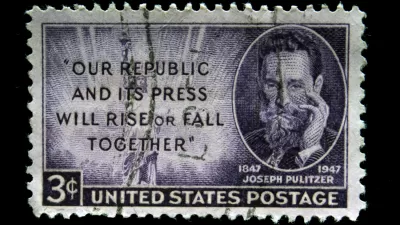Inga Saffron recently joined a very small group of architecture critics to win the Pulitzer Prize. What does her victory say about the state of criticism, especially built environment criticism, today?
Kriston Capps explains the significance of Inga Saffron’s recent selection as a Pulitzer Prize laureate for criticism, which moves the Philadelphia Inquirer architecture critic into select company: “This significance for the field of architecture criticism at large shouldn't be lost, either. Saffron is the first architecture critic to win the award since 1999, when Blair Kamin took it for the Chicago Tribune. Saffron is only the sixth architecture critic to receive the Pulitzer Prize for criticism since it was introduced in 1970, when Ada Louise Huxtable won the award for more or less inventing the field of architecture criticism for The New York Times.”
Not only are architecture critics rarely celebrated by the Pulitzer committee, they are also rare, period. U.S. newspapers currently employ only 13 full-time architecture critics. But rather than lamenting the dearth of critics, Capps makes an important distinction: “While newspapers today employ fewer critics than they have in the past, there is almost certainly more architectural criticism written today than at any point in journalism's history.”
A final, noteworthy point from the article: “In one sense, prizes like the Pulitzer appear to belong to a legacy media that is vanishing rapidly. But that doesn't mean that it's any less important as an inspiration for the next generation of writers. (And readers. And architects, too.) If Saffron's work matters—and plainly it does—then it will continue to shape the dialog about architecture even as the format of that conversation changes.”
FULL STORY: What Inga Saffron's Pulitzer Prize Means for Criticism

Maui's Vacation Rental Debate Turns Ugly
Verbal attacks, misinformation campaigns and fistfights plague a high-stakes debate to convert thousands of vacation rentals into long-term housing.

Planetizen Federal Action Tracker
A weekly monitor of how Trump’s orders and actions are impacting planners and planning in America.

In Urban Planning, AI Prompting Could be the New Design Thinking
Creativity has long been key to great urban design. What if we see AI as our new creative partner?

How Trump's HUD Budget Proposal Would Harm Homelessness Response
Experts say the change to the HUD budget would make it more difficult to identify people who are homeless and connect them with services, and to prevent homelessness.

The Vast Potential of the Right-of-Way
One writer argues that the space between two building faces is the most important element of the built environment.

Florida Seniors Face Rising Homelessness Risk
High housing costs are pushing more seniors, many of them on a fixed income, into homelessness.
Urban Design for Planners 1: Software Tools
This six-course series explores essential urban design concepts using open source software and equips planners with the tools they need to participate fully in the urban design process.
Planning for Universal Design
Learn the tools for implementing Universal Design in planning regulations.
Gallatin County Department of Planning & Community Development
Heyer Gruel & Associates PA
JM Goldson LLC
City of Camden Redevelopment Agency
City of Astoria
Transportation Research & Education Center (TREC) at Portland State University
Jefferson Parish Government
Camden Redevelopment Agency
City of Claremont




























